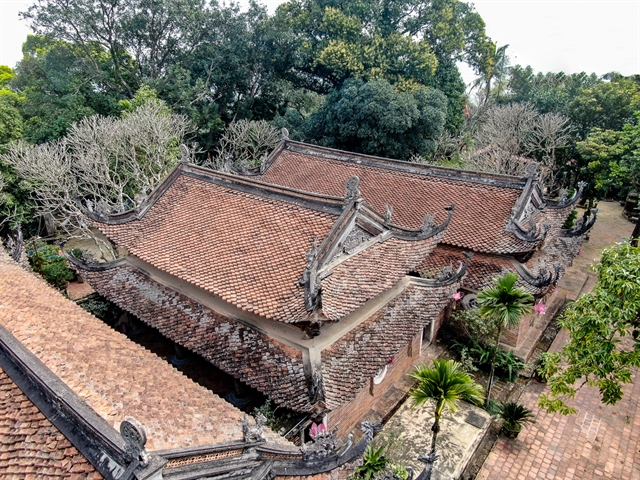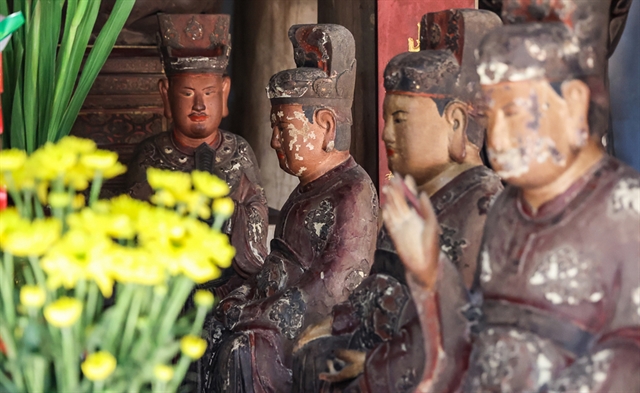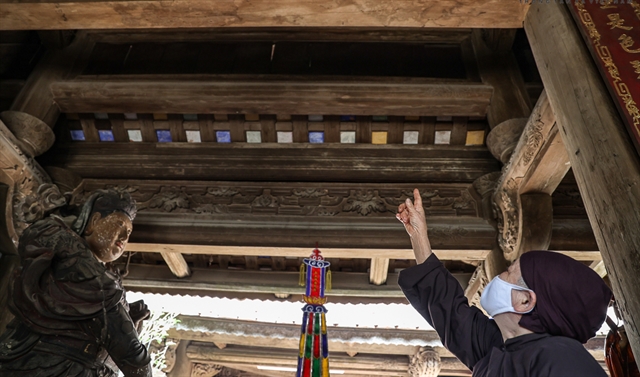 Sunday/Weekend
Sunday/Weekend

The capital city of Hà Nội takes pride in being a place with priceless cultural and historical heritages, and home to the most special national monuments in the country.
The restoration of these relic sites, which have a history of hundreds to thousands of years, presents managers with several challenges since they require urgent and specialised conservation.
Tây Phương Pagoda, located in Thạch Thất District on the outskirts of Hà Nội, is one of the city's most popular cultural and religious sites.
The pagoda has been severely degraded over time and faces a risk of collapse, which could damage the centuries-old statues inside.
 |
| Tây Phương Pagoda in Thạch Thất District has been severely damaged after hundreds of years of existence. VNA/VNS Photo |
It is a combination of three pagodas, Hạ, Trung and Thượng, all built in the 17th century. It is also home to many masterpieces of Vietnamese Buddhist sculptures of the 18th century.
After many years without proper care, the pagodas' main features have deteriorated. At the Trung and Thượng pagodas, columns and pillars have termite damage, while parts of Hạ Pagoda's tiled roofs have leaks when it rains.
 |
| Tây Phương Pagoda is home to many masterpieces of Vietnamese Buddhist sculptures of the 18th century, which are in poor condition. VNA/VNS Photo |
The entrance's laterite steps to the temple were broken, making it a hazard for visitors. Many ancient statues have flaking paint or broken bases.
"The problems will get worse if no action is taken. Given that the pagoda's protection zone lies within a decades-old residential area, it is urgent to make plans for the relocation of the residents to provide sufficient space for restoration works," said Nguyễn Trường Giang, head of the district's culture and information authority.
Many other relic sites in Hà Nội are in the same situation. However, several issues are standing in the way of restoration efforts.
In many cases, a lack of expertise in restoration and preservation has led to irreparable damage to relics.
Removing barriers
Lê Xuân Kiêu, director of the Văn Miếu – Quốc Tử Giám Centre for Cultural and Scientific Activities, said the biggest obstacles to restoring a heritage relic were shortcomings of the Law on Planning and lack of funding.
He called on regulators to address legal issues hindering the development of plans for a restoration project.
Director of the Hà Nội Department of Culture and Sports Đỗ Đình Hồng spoke about the limitations of restoring a special national monument, saying that when a monument has deteriorated severely, it is important to act promptly to secure the original elements.
 |
| Tây Phương Pagoda's leaky roof. Historic and religious sites require urgent and specific protection to preserve their originality. VNA/VNS Photo |
He said that the renovation must complete all appropriate processes and that the department is responsible for presenting these procedures to the Hà Nội People's Committee and the Ministry of Culture, Sports, and Tourism.
Director Hồng underlined the necessity of closely monitoring the investment and renovation process to avoid problems and to take the implementation of the authorised investment project seriously.
He also stated that the department would establish a heritage advisory council to assist localities with special national monuments and other monuments undergoing restoration.
To remove barriers to the restoration of heritage sites, Vice Chairman of Hà Nội People's Committee Chử Xuân Dũng ordered the City's Department of Culture and Sports to issue instructions for properly planning restoration projects and how they should be submitted to the Ministry of Culture, Sports and Tourism for verification and approval.
He said the department must also strengthen coordination with concerned units and local administrations to intensify inspection and monitoring of restoration works and prevent unlawful restoration attempts.
The capital city's authorities have pledged to boost the public investment plan for 2021-25 by pouring over VNĐ14 trillion (US$600 million) into restoring and embellishing a total of 579 heritage sites in the area.
According to the municipal People's Council, the sum is a significant part of its financial supplementation plans for a five-year term and the allocation for 2022, including investment plans in building and renovating public schools, upgrading the public healthcare service, as well as restoring and upgrading heritage sites from 2022 to 2025.
According to Dũng, heritage site restoration has been one of the city's three major investment plans for 2021 to 2025.
"The city's authorities have requested departments, agencies and localities to focus on the plan, not merely on construction works, but they should be 'cautious' as it contains cultural and spiritual elements," the official said.
In 2018, Hà Nội spent more than VNĐ40.8 billion on urgent repairs of 50 heritage monuments. VNS




